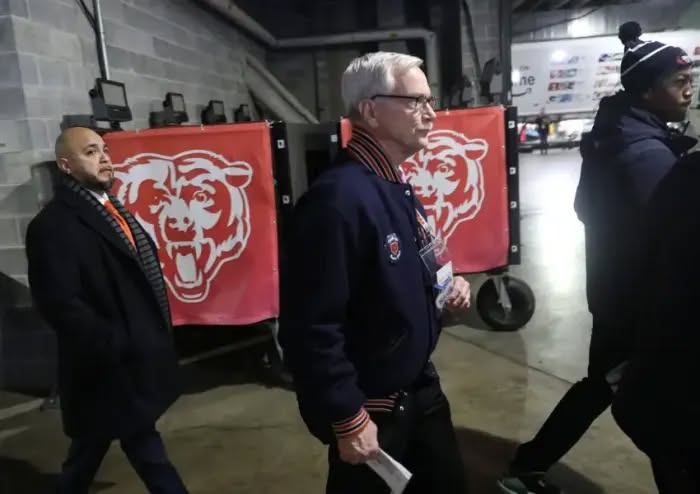The Chicago Bears have long been one of the most storied franchises in the National Football League. With a history dating back to the NFL’s founding in 1920, the Bears have been a symbol of tradition, toughness, and defensive dominance. Yet, like many legacy franchises, they have not been immune to controversy. While several disputes have touched the Bears over the years—from coaching decisions to draft busts—one of the most significant and wide-reaching controversies involving the team came during a period where organizational instability, questions of leadership, and broader NFL policy converged. This situation didn’t just affect Chicago; it reverberated across the league, raising questions about team management, the NFL’s role in oversight, and the long-term health and direction of the sport itself.
The controversy in question unfolded during a period of tumultuous rebuilding for the Bears, where a combination of ownership decisions, coaching turnovers, and player management all began to collide. After years of inconsistency following their 2006 Super Bowl appearance, the franchise struggled to maintain a coherent identity. Management decisions were constantly under fire, most notably those involving the quarterback position, which saw a carousel of underwhelming starters and failed draft picks. Yet, the real controversy began to build when the team made high-profile moves that were met with internal and external criticism.
One major flashpoint came with the hiring of a new general manager and head coach duo. The decisions around this leadership change were seen by many analysts and former players as lacking transparency and grounded planning. Rumors began to swirl that ownership had made promises or decisions without fully consulting football operations or following standard due diligence. Critics accused the organization of being more focused on optics than substance, leaning into splashy headlines while failing to establish a solid foundation.
The situation worsened when internal reports leaked suggesting there was tension between the new front office and existing scouting staff. Disagreements over draft picks, free agency targets, and the general vision for the team created a fractured internal culture. This discord spilled into public view during press conferences where vague answers and obvious deflections from leadership led many to believe that not everyone within the Bears’ organization was on the same page. Media scrutiny intensified, and longtime Bears fans began to question whether the team’s decision-making process was guided by football acumen or by off-field interests.
One particular controversy erupted during the NFL Draft, when the Bears traded up to select a quarterback that many believed could have been available without sacrificing valuable draft capital. Analysts noted that the move felt panicked, perhaps influenced by fan pressure and a desire to demonstrate action rather than effectiveness. The quarterback, while talented, was not viewed as a guaranteed franchise savior, and the steep cost raised eyebrows across the league. Internally, there were reports that some scouting personnel had rated other players higher, but their input had been overridden by top-level executives seeking to make a bold statement.
This decision placed tremendous pressure on the rookie quarterback, whose every move was scrutinized in a city desperate for football relevance. He was thrust into a starting role behind a makeshift offensive line and a limited supporting cast. Predictably, struggles followed. Rather than allowing for growth, fans and the media began to turn on the front office, questioning not only the choice but the entire development plan. The quarterback’s growth was hindered by constant coaching changes and a lack of consistency in offensive philosophy—symptomatic of a deeper institutional issue within the Bears’ leadership.
At the same time, a new layer of controversy began to unfold surrounding the Bears’ future stadium situation. Ownership had made moves to acquire land in the Chicago suburbs, signaling a potential departure from Soldier Field, the team’s home since 1971. While the move was positioned as a business decision aimed at providing a more modern fan experience, critics saw it as a betrayal of the team’s identity. Fans, city officials, and local businesses decried the proposed relocation as a cash grab that ignored the team’s historic connection to Chicago’s downtown core. The situation ignited a legal and political battle, with the city threatening lawsuits and attempting to negotiate to keep the team within city limits.
This stadium issue brought the Bears under increased national scrutiny. The NFL, which usually avoids becoming entangled in individual teams’ local affairs, found itself being dragged into the debate as questions were raised about whether the league was doing enough to ensure teams honored their local fan bases and civic commitments. The broader implication became part of a nationwide conversation about NFL teams leveraging potential moves to extract public funding and tax breaks. The Bears’ situation became a prime example, raising ethical questions about the intersection of sports, business, and public trust.
At the heart of this controversy was also the question of what responsibility the NFL had in ensuring team stability and operational integrity. Critics argued that the league, by turning a blind eye to ownership dysfunction, was complicit in allowing teams like the Bears to flounder due to poor leadership. There were calls for the NFL to impose more stringent checks on how teams manage their front offices and coaching decisions, especially when performance consistently falters over years or decades.
Another dimension to the controversy was how player development was being handled. Several former Bears players spoke out, either anonymously or after retiring, suggesting that the team lacked a coherent plan to nurture talent. They pointed to inconsistent coaching, a lack of communication between units, and even allegations of medical mismanagement. One player claimed that the team’s approach to injury rehabilitation was outdated and led to prolonged absences or aggravated issues. These claims, while difficult to verify, painted a troubling picture of internal operations and raised serious concerns about player health and career longevity.
The tension reached a boiling point when a prominent veteran player requested a trade mid-season, citing frustrations with the team’s direction. The trade request, which was eventually granted, became symbolic of the dysfunction gripping the franchise. It led to a wave of criticism not just from fans but also from other players around the league, some of whom expressed solidarity and even questioned whether the Bears were a desirable destination for free agents. When your own peers begin to publicly question your credibility as a team, it’s clear something deeper is wrong.
In response to mounting public pressure, the Bears eventually launched a comprehensive internal review of their football operations. A new wave of consultants and analysts were brought in to diagnose the structural issues plaguing the team. Though such a move suggested a desire to change, many were skeptical. After all, this wasn’t the first time the organization had promised a reset. Critics were quick to point out that without changes at the ownership level or at least in the decision-making structure, meaningful reform would be difficult to achieve.
This extended controversy ultimately forced the NFL to examine its broader role in team oversight. It sparked discussions among league owners and executives about how to handle franchises that appear to be consistently mismanaged. Though the league prides itself on parity, the Bears’ situation seemed to represent a failure of that system—a once-proud franchise mired in dysfunction due to poor leadership and inconsistent vision.
The controversy didn’t have one single villain or flashpoint. Rather, it was a complex convergence of missteps, ambitions, and misaligned interests. From rushed quarterback decisions to stadium relocations, from internal strife to public outcry, the saga served as a cautionary tale of what happens when a franchise loses its foundational identity. The Chicago Bears, for all their history and legacy, became a central figure in a broader reckoning about team ownership, league governance, and the delicate relationship between a city and its team.
In the end, the controversy didn’t just impact the Bears; it forced the NFL and its fans to ask harder questions. What does responsible team management look like? How should the league hold its franchises accountable? And perhaps most importantly, what does a team owe to its players, its fans, and the city it calls home? The Chicago Bears may not have set out to become the center of a major NFL controversy, but through a series of compounded missteps and opaque leadership, they found themselves at the heart of one of the most important conversations in modern football.



